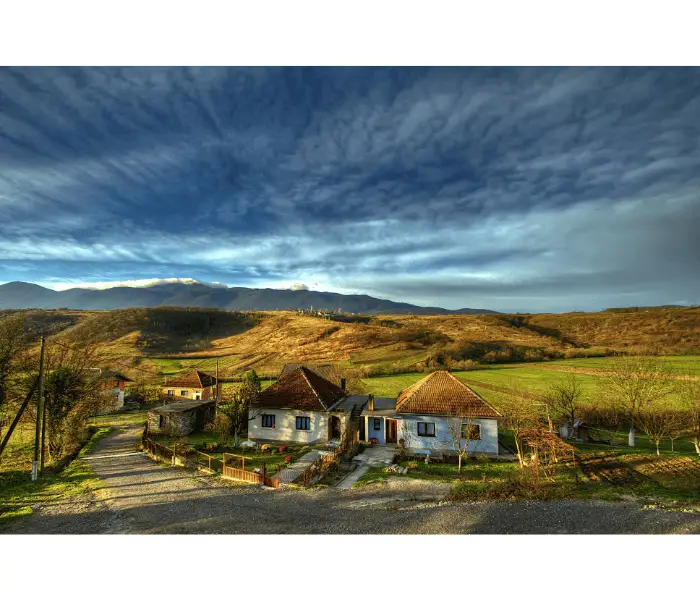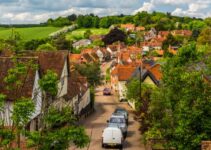Although villages are already quite small, the smallest villages have their own name. In British governance, there’s even a specific population limit defining villages, small villages, and towns.
In this article, we’ll look at the term we use for a small village, how we define it, and any other differences applied to settlement types.
What is a Small Village?
In British English, a small village is called a hamlet. It’s the smallest recognised type of human settlement in the UK and can consist of anything from two or three houses on a road to a slightly larger collection of properties.
We won’t get too deep into the differences between a village and a hamlet, as we have a whole article on that. However, it’s worth mentioning that a hamlet doesn’t have public meeting places (such as a hall or pub), and often lacks public services, such as shops.
Once it gets these, we call it a village.

Small Village Meaning
So, technically, a small village and a hamlet can be different things. However, villages have a set population limit. Provided the population is within this boundary and it’s got public spaces, it’s a village.
The word hamlet comes from a French term meaning “small village”. Similarly, the Welsh word, pentrefan/pentrefyn, means small village. Finally, the Scot-Gaelic term, clachan, means essentially the same thing.
However, you might also hear a hamlet called a ferm toun, meaning farm town.

How Small is a Village?
In the UK, a normal village can have a population of up to 7,500 residents. After that, it’s often regarded as a town. So, a small village could be anything on the lower end of this scale.

Small Village Population
Elsewhere in the world, geographers define a village as having a population of between 500 and 2,500. This would probably be a better definition of a small village’s population, as there won’t be much that’s small about an area housing 7,500 people!
A hamlet (small town) is typically thought to have a population of 100 residents or so, but this can depend on numerous factors. Generally in the UK, there aren’t massively strict definitions of settlement population sizes.
Instead, the government works on provided amenities. However, a lot of these are tied to population. For example, a village with pubs and shops will typically have a larger population than a few houses scattered along a road.
What is the Smallest Village in the UK?
It’s difficult to define the smallest village in the UK, as many have a population of just a few hundred residents. Plus, the definition of a village is less clear than that of a town, so it can be impossible to determine when an area is a village and, by extension, how big its population is.
Instead, we can look at the smallest town and city, as these are much easier settlements to define. The smallest town in the UK is Fordwich, in Kent.
It has a population of 400, making it also a small village! Fordwich has a town council, so is technically a town. It lost this status in 1880 but regained it in 1972.
The smallest city is St Davids in Pembrokeshire, Wales. It has a population of just 1,600, making it smaller than a lot of towns. It’s defined as a city because it has a cathedral (one of the standard markers of a city).
What is the Difference Between a Small Town and a Village?
The main difference between a small town and a village is, again, the types of buildings and amenities it contains. A town has a different form of government than a village, and in the UK, most are historical market towns.
Unsurprisingly, this meant the area had permission to hold a weekly market.
The term “small town” isn’t used very much in the UK. Instead, we’d typically use just town or village if it’s a small settlement. This is because population isn’t an official marker of settlement type, as is obvious when you start trying to differentiate a village from a hamlet.
Instead, small town is more commonly used in the US to refer to settlements that we’d call villages. So, something that would be a village or hamlet in the UK would be called a small town in the US.
However, the differences between a small town and a village in the UK are as follows:
· A town is typically the economic hub of a local area, where people from surrounding villages will travel to.
· A town has a town council as its government. This will then govern surrounding villages or parishes.
· A village often has historical markers and buildings, such as a church, village green, and small shop. A town, however, will usually have a market square or other built-up centre.
· Towns are generally larger and have a higher population and more built-up area. However, this isn’t always the case, as towns can have smaller populations than villages, and villages higher than towns.
Although it’s not difficult to define a town, population size often has little to do with it. This is because populations can change rapidly, so settlements would move around these boundaries regularly.
What Do you Call a Small Village?
A small village isn’t a typical term used in the UK because we have an actual word for it. That said, we use the term informally if a village is simply small and we want to describe it.
Either way, next time you’re walking around the British countryside, you’ll now be armed with all the information you could need to describe local settlements!


